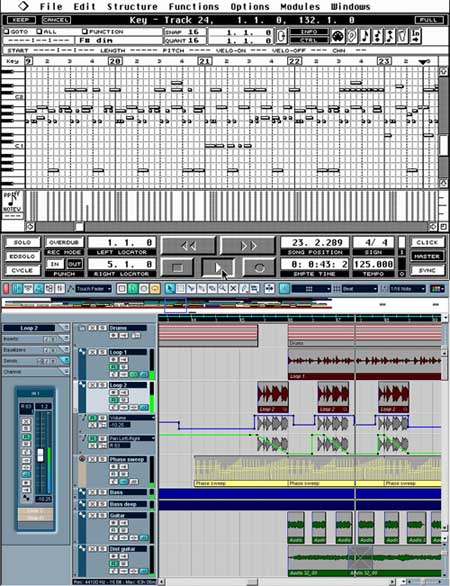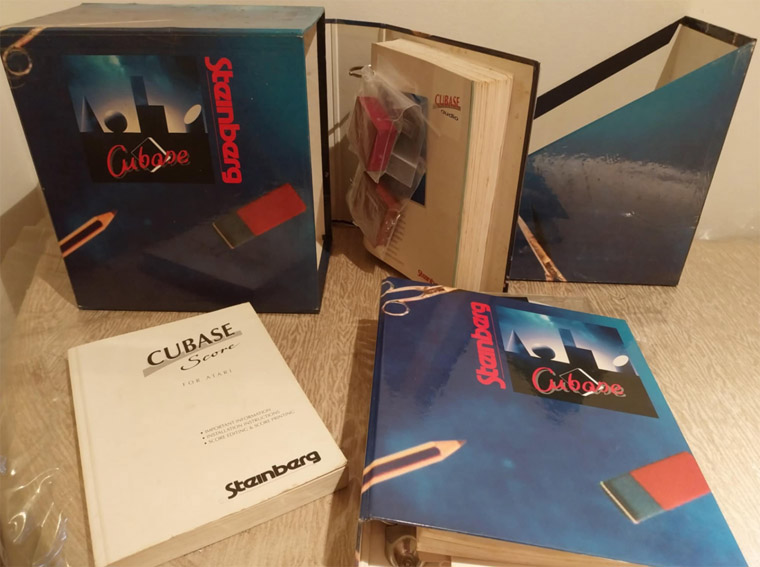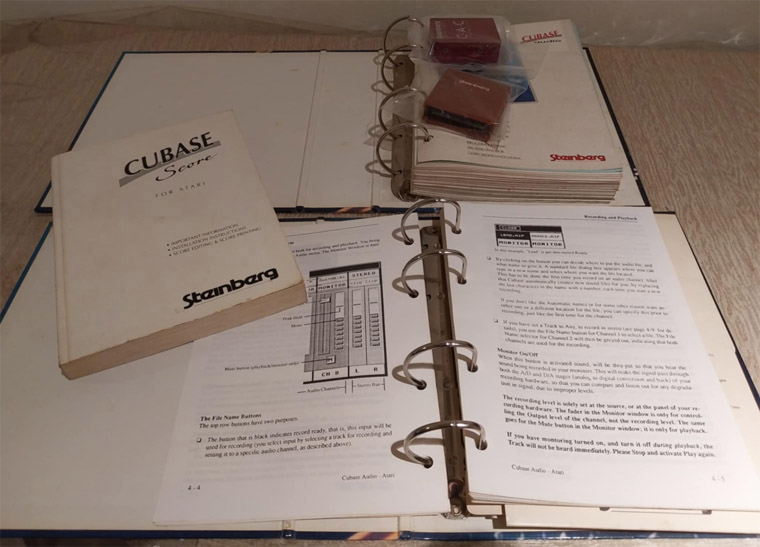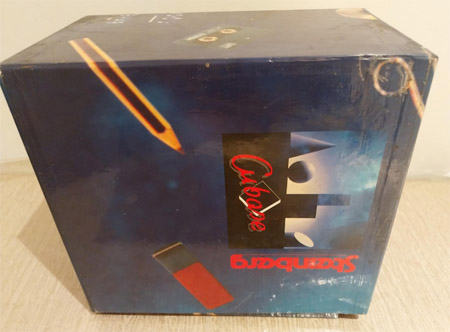A milestone in digital music production.
Launched in April 1989 for the Atari ST, Cubase was a groundbreaking MIDI sequencer, praised for its user-friendly interface and advanced features that set new standards in music production
- Initially sold as a MIDI-only sequencer for the Atari ST (Cubase 1)
- Among the many legendary bands that utilized Cubase on Atari ST computers were Depeche Mode, Pet Shop Boys, and Tangerine Dream
- Digital audio recording capabilities were added later, and it became also available for Macintosh and Windows-based systems
- Over time, Cubase has evolved from a basic MIDI sequencer into a powerful digital audio workstation that fully supports VST (Virtual Studio Technology) instruments and effects
🎼 Early Cubase Software Releases (1989-1994)
This is a brief history of the early Cubase software releases for the Atari ST line of computers. An expanded timeline follows later, covering subsequent Cubase versions through to the modern era.
🎹 Cubase 1 (1989): Allowing MIDI sequencing, some audio recording, and basic mixing tools.
- Atari 520/1040/Mega ST(e) with 1 MB minimum RAM
🎹 Cubase 2 (1991): Improved audio handling, additional MIDI features, and better interface options.
- Atari 520/1040/Mega ST(e) with 1 MB minimum RAM
🎹 Cubase Lite (1992): Cubase Lite is an entry-level version of Cubase.
- Atari 520/1040/Mega ST(e) with 1 MB minimum RAM
🎹 Cubase 3 (1993): Featured enhancements such as improved real-time effects processing, more track counts, and enhanced editing tools. This series helped establish Cubase as a professional-grade music production platform.
- Atari 520/1040/Mega ST(e) or TT with 1 MB minimum RAM
- Atari Falcon 030 version
 ♫ Cubase Score (1994)
♫ Cubase Score (1994)
Cubase Score focuses more on notation and music scoring. This package is tailored for composers and arrangers who need to create and edit sheet music. It combines Cubase’s sequencing power with advanced notation tools, allowing users to write music in traditional score format while also hearing playback with MIDI or audio instruments.
- Atari 520/1040/Mega ST(e) or TT with 2 MB minimum RAM
- Atari Falcon 030 version
🔊 Cubase Audio (1994)
Cubase Audio is geared towards users who want a strong focus on audio recording, editing, and mixing. It typically provides more robust audio track capabilities, higher audio quality, and advanced editing tools compared to earlier or lighter versions. Ideal for musicians and producers who record live instruments or vocals and want full control over audio processing and mixing.
- Atari Falcon 030 version (recommended 14 MB RAM and a large hard-disk)
🛠 Cubase for Atari ST Features
Cubase for Atari ST offers a variety of composition-focused features::
-
Arrangement
-
Drag-and-Drop Workflow: Songs could be structured effortlessly by dragging and dropping “Parts” within the arrangement window, streamlining the creative process.
-
Part Editing: Users had full control over Parts, with options to duplicate, delete, overlap, merge, paste, cut, split, join, extend, attenuate, delay, or mute them.
-
Track Management: Parts could be moved across tracks, selected individually or in groups, and organized into musical sections such as verses, choruses, or instrument layers.
Recording
-
Count-In and Punch-In: Cubase allowed for a two-bar count-in or starting playback from a specified point, making it easier to record over existing material.
-
Human Sync: This feature attempted to align recording tempo with a user-defined tempo, with adjustable levels of synchronization support.
-
Chase Events: To ensure accurate playback before recording, this function scanned backward for the most recent MIDI Program Change message to set the correct synth patch.
Editing
-
Score Editor: Users could input notes and rests directly into traditional notation. Reprogramming parts was as simple as playing a new note on the keyboard.
-
Quantize and Snap: Timing corrections could be applied using quantize settings, while Snap ensured note placement adhered to specific rhythmic values during manual editing.
-
Logical Editing: Introduced in Cubase 3.0, this feature offered advanced MIDI editing capabilities through rule-based transformations.
-
Window Management: The Arrange and Score windows could be resized to appear simultaneously, though this reduced the visible number of staves in the score editor.
Other Features
-
Disk Formatting: Basic disk formatting tools were available within the application.
-
Keyboard and Mouse Access: Most functions could be controlled using either the Atari's keyboard or mouse, enhancing workflow flexibility.
-
Multi-Program Support: Cubase could operate alongside other applications via the MROS switcher, provided sufficient memory was available.
-
Resolution Upgrade: Cubase 3.0 featured a resolution of 384 pulses per quarter note—double that of version 2.0—allowing for more precise timing.
-
🔊 Cubase Audio for the Atari Falcon 030
 Cubase Audio for the Atari Falcon 030 marked a major advancement, introducing support for 16 audio tracks with 2:1 compression and a range of enhancements over earlier versions. Key improvements included 48kHz sample rate support, faster file handling, new offline effects, and an upgraded inspector panel. The update also featured a 10-band graphic equalizer, a 16-channel mixer, and resolved previous issues related to SCSI timeouts and long file name compatibility.
Cubase Audio for the Atari Falcon 030 marked a major advancement, introducing support for 16 audio tracks with 2:1 compression and a range of enhancements over earlier versions. Key improvements included 48kHz sample rate support, faster file handling, new offline effects, and an upgraded inspector panel. The update also featured a 10-band graphic equalizer, a 16-channel mixer, and resolved previous issues related to SCSI timeouts and long file name compatibility.
-
Audio Tracks: Supported up to 16 audio tracks with 2:1 compression, delivering 16-bit output quality.
-
Sample Rates: Expanded sample rate options, including support for 48kHz—a significant improvement over earlier versions, as noted by Sound On Sound.
-
File Handling: Post-recording file management saw major speed improvements, streamlining the workflow.
-
Offline Effects: New offline processing tools were added, including tape-style pitch adjustment and conversion between track modes.
-
Inspector Panel: The inspector panel received useful upgrades, featuring options for muting, monitoring, file naming, displaying free disk space, and naming parts. Importantly, muting via the inspector did not interrupt ongoing audio playback.
-
Equalizer and Mixer: The update included a 10-band graphic equalizer and new 16-channel mixer pages for more flexible sound shaping and control.
-
SCSI Improvements: Software fixes resolved previous problems with SCSI timeouts and long file name handling, improving system reliability.
🕰️ Cubase Complete Timeline and Modern Enhancements
 Early Days – MIDI Sequencing Beginnings
Early Days – MIDI Sequencing Beginnings
- 1989: Cubase 1.0 launched exclusively for Atari ST computers, focusing purely on MIDI sequencing.
- Early 1990s: Cubase expanded to both Macintosh and Windows platforms
- 1992: Cubase 2.0 and Cubase Lite for the Atari ST
- 1992: Cubase Audio debuted on Mac, introducing audio recording capabilities alongside MIDI sequencing—a major leap in functionality.
- 1993: Cubase 3.0 for the Atari ST, along with a version customized for the Falcon 030
- 1994: Cubase Score for the Atari ST, along with a version customized for the Falcon 030
- 1994: Cubase Audio for the Atari ST, along with a version customized for the Falcon 030
The VST Revolution
- 1997: Cubase VST 3.5 introduced Virtual Studio Technology (VST), enabling third-party plugin integration and marking the shift toward complete audio production.
- 1999: Cubase VST 3.7 (Windows) brought in VST 2.0, which supported VST instruments (VSTi), laying the groundwork for modern software instruments.
Cubase SX and Major Redesigns
- 2002: Cubase SX 1.0 was a full rewrite of the program, introducing a new audio engine, advanced automation, and 5.1 surround sound support.
- 2003: Cubase SX 2.0 added plug-in delay compensation (PDC) and the Time Warp tool for flexible tempo mapping.
- 2004: Cubase SX 3.0 introduced AudioWarp, allowing for real-time time-stretching and tempo changes without affecting pitch.
- 2006: Cubase 4.0 dropped support for DirectX plugins, shifted fully to VST3, and unveiled a newly redesigned user interface.
- 2009–2020): Cubase released a steady stream of major updates—versions 5 through 11—each adding new features, plugins, workflow improvements, and performance enhancements.
Recent Versions
- 2022 – Cubase 12: Focused on MIDI Remote integration, refined performance, and overall stability.
- 2023 – Cubase 13: Introduced new creative tools and streamlined workflows aimed at modern music producers.
- 2024 – Cubase 14: Continued the trend with further enhancements, new features, and workflow improvements, pushing the platform into its next generation.
🔗 Sources:
- https://forums.steinberg.net/
- https://www.atarimania.com/list_utilities_atari-st-steinberg_publisher_3238_S_U.html
- https://en.wikipedia.org/wiki/Cubase
![]() > FIND MORE
> FIND MORE
| □ BinaryValue.com |
📌 GENERAL LINKS |
» About | » Retro Collection | » Software Collection |
| » Roland MT-32 Midi | » Posters (+) | |||
|
📌 NOTABLE APPS |
» Cubase by Steinberg | » Deluxe Paint by EA | ||
|
📌 COLLECTIONS |
» Psygnosis Games | » Lucasfilm Games | » Sierra On-Line Games | |
| » Delphine Software Games | ||||
|
📌 COMPUTER GAMES |
» Dragon's Lair and Space Ace | » Mortal Kombat by Midway | » Golden Axe by Sega | |
| » KGB by Virgin |







